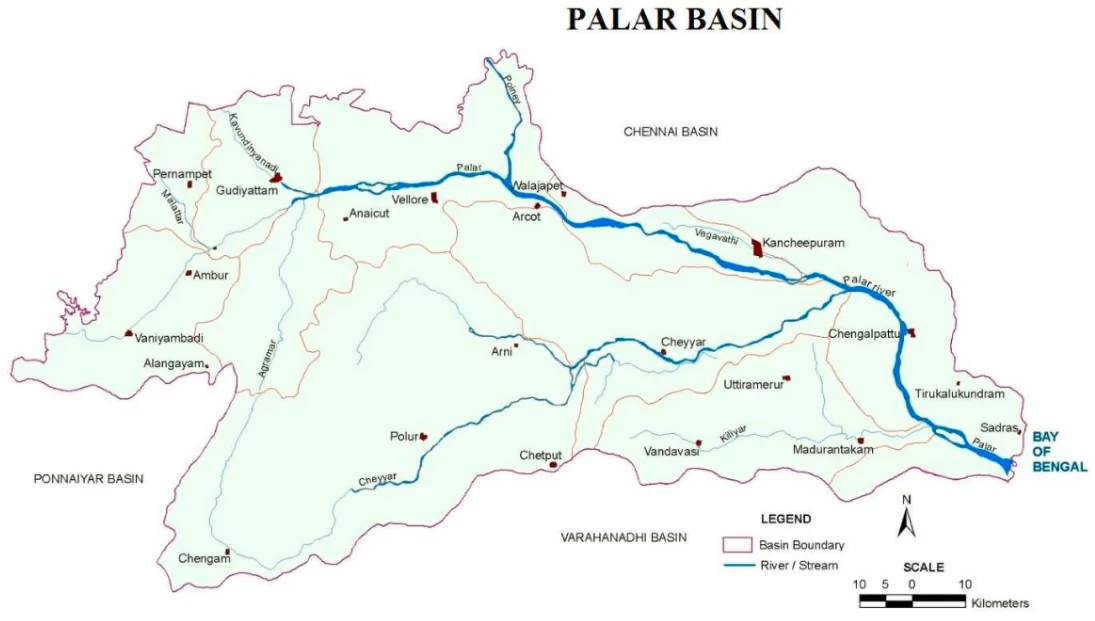The Supreme Court has held that tanneries in Vellore district, Tamil Nadu, have caused irreversible environmental damage by discharging untreated or partially treated effluents into the Palar River.
- The court directed the Tamil Nadu government to compensate the affected individuals, with the cost to be recovered from the polluting units under the ‘Polluter Pays’ principle.
Key Observations by the Supreme Court
- Sustainable Development:
- Sustainable Development means meeting our needs today without harming the ability of future generations to meet their own needs.
- The court reaffirmed that the “Precautionary Principle” and the “Polluter Pays Principle” are essential features of Sustainable Development.
- It stressed the need for balancing environmental conservation with economic activities.
- Polluter Pays Principle:
- This principle mandates that those responsible for pollution must bear the cost of managing it to prevent harm to human health and the environment.
- This ensures that polluters take responsibility and helps fund environmental restoration efforts.
- Precautionary Principle:
- If an activity might cause serious harm to the environment or human health, preventive action should be taken, even if scientific proof is not complete.
- This principle encourages proactive environmental protection rather than waiting for conclusive proof of damage.
Enroll now for UPSC Online Classes
Directions to Tamil Nadu Government
- Formation of an Expert Committee: The Tamil Nadu government, in consultation with the central government, has been directed to constitute an Expert Committee within four weeks.
- Strict Licensing Measures: Authorities must cancel the licenses of industries that misrepresent information or violate environmental regulations.
What are Tanneries?
- Tanneries are factories where animal hides are processed and transformed into leather.
- The leather industry is one of the most polluting industries due to the toxic chemicals used in processing.
Impact of Tanneries on the Environment
- Water Pollution: Tanneries discharge toxic chemicals such as chromium, sulfides, and acids into water bodies.
- Groundwater Contamination: Unchecked disposal leads to high levels of pollutants in groundwater, making it unsafe for drinking and agriculture.
- Soil Degradation: Toxic effluents degrade soil quality, impacting agricultural productivity.
- Health Hazards: The pollution affects local communities, causing respiratory issues, skin diseases, and other health concerns.
Landmark Supreme Court Judgments on Environmental Protection
Rural Litigation and Entitlement Kendra vs. State (1988)
- Recognized the right to live in a healthy environment as part of Article 21 of the Constitution.
- Ordered the closure of limestone quarries in Dehradun to protect the environment.
M.C. Mehta vs. Union of India (1987)
- Established that the right to a pollution-free environment is a fundamental right under Article 21.
- Ordered industries in Delhi to adopt environmental safeguards.
T.N. Godavarman Thirumulpad vs. Union of India (1996)
- Expanded the definition of ‘forest’ to include all green expanses, regardless of classification or ownership.
- Strengthened forest conservation efforts across India.
|
Check Out UPSC NCERT Textbooks From PW Store
About the Palar River
- The Palar River is one of the major rivers in southern India, playing a vital role in the ecology and economy of the regions it flows through.
- Origin and Course: The Palar River originates in the Nandi Hills, located in the Chikkaballapura district of Karnataka.
- It flows through three states: Karnataka, Andhra Pradesh, and Tamil Nadu, before finally emptying into the Bay of Bengal at Vayalur in Tamil Nadu.
- Major Tributaries: The Palar River is fed by several tributaries, the most significant being the Cheyyar and Ponnai rivers, both located in Tamil Nadu.
- Water Diversion: Water from the Palar River is diverted through the Palar anicut (a traditional water diversion structure) to two important reservoirs:
- Poondi Reservoir: Located in the Kosasthalaiyar River basin, this reservoir helps meet the water needs of the region.
- Chembarambakkam Lake: Situated in the Adayar River basin, this lake is a crucial source of water for irrigation and drinking purposes.

Ready to boost your UPSC 2025 preparation? Join PW’s UPSC online courses today!
![]() 1 Feb 2025
1 Feb 2025


